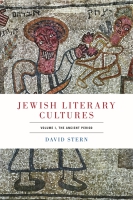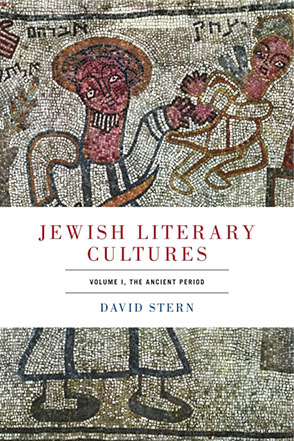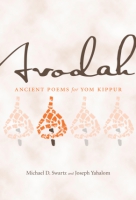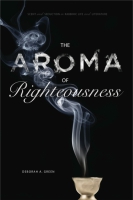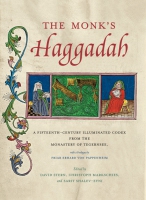Jewish Literary Cultures
Volume 1, The Ancient Period
David Stern
“This engaging and insightful collection illustrates the value of viewing together what originally were disparately published writings. The book will be of great interest to scholars of the rabbinic literature and of hermeneutics and literary theory more generally. Highly recommended.”
- Description
- Reviews
- Bio
- Table of Contents
- Sample Chapters
- Subjects
“This engaging and insightful collection illustrates the value of viewing together what originally were disparately published writings. The book will be of great interest to scholars of the rabbinic literature and of hermeneutics and literary theory more generally. Highly recommended.”
“How fitting for David Stern’s articles and essays to be anthologized so beautifully, considering his own contribution to our appreciation of the role of anthology in the shaping of early rabbinic midrash as commentary. Stern has a magical textual touch, which he employs to deepen our understanding of both the literary and the material dimensions of rabbinic and, more broadly, Jewish culture in constant conversation with variegated theoretical and practical perspectives. This harvest of over three decades of his scholarship demonstrates his unequaled range, variety, and depth as a most illuminating and challenging reader of rabbinic literary culture in its many manifestations.”
David Stern is the Harry Starr Professor of Classical and Modern Hebrew and Jewish Literature at Harvard University and coeditor of The Monk’s Haggadah (Penn State, 2015).
Contents
Acknowledgments
Introduction
1 Vayikra Rabbah and My Life in Midrash
2 The Beautiful Captive: The Rabbinic Imagination, the Greco-Roman Novel, and the Dangerous Gentile Female
3 Ancient Jewish Interpretation of the Song of Songs in a Comparative Context
4 On Comparative Biblical Exegesis—Interpretation, Influence, Appropriation
5 Anthology and Polysemy in Classical Midrash
6 The Fables of the Jews: From the Hebrew Bible Through Rabbinic Literature
7 On Canonization in Rabbinic Literature
8 The First Jewish Books and the Early History of Jewish Reading
Notes
Credits
Introduction
This book is the first of three volumes of my collected essays and articles that Pennsylvania State University Press will publish over the next several years. The volumes are organized around the contents of the essays, not the order in which I wrote them. This volume deals with texts and topics from ancient Jewish literature; the second volume will treat Jewish literature from the medieval and early modern periods; the third, modern and contemporary Jewish literary texts. By literature and literary texts, I mean not just the conventional genres and types of writing with which we are most familiar but all kinds of written texts that have given expression to Jewish literary creativity, including (in more than a few cases) commentaries and other types of anthological works.
The overall title for the three volumes, Jewish Literary Cultures, reflects my belief that Jewish literary culture exists and that it has never been a single thing. In the course of the past two thousand years, the literature of the Jews has changed and developed, taking on different shapes and forms from one period to the next and from one geographical center in the Diaspora to another. The essays in these three volumes reflect my personal commitment to, and interest in, the totality of Hebrew literature in its full historical range. Whether or not that literature has constituted a continuous or coherent tradition is not a question I wish to address, but throughout my career the topic that has consistently engaged my scholarly imagination has been the question of Jewish literary creativity, its peculiar dynamics and vastly different manifestations. Needless to say, no one can do everything, and I have no pretensions to have exhausted the deepest sources or full range of that creativity, but in exploring its changing nature through the length of Jewish history, it is my hope that I will at least have helped uncover and demonstrate its range, variety, and depth.
The essays in the three volumes span the past thirty years of my career as a scholar. During this period, my scholarly interests in ancient Jewish literature have shifted: from questions of hermeneutics and the mechanics of ancient scriptural interpretation to more thematic and cultural themes; and from a preoccupation with the intersection of narrative and exegesis in the literary forms of midrash (and rabbinic literature more generally) to the history of the material Jewish text and the impact of materiality on reading practices and literary reception. Such shifts in interests are not unusual; they naturally occur as part of the normal course of development (and aging) and are the best and only ways that scholars have to rejuvenate and reinvent themselves and remain engaged with the material.
In reviewing the articles for this collection, I have nonetheless been struck by the recurrence of certain themes and problems. I now see I was working them out for myself in the course of dealing with a scattered range of otherwise unconnected topics, often not even fully aware that I was doing so. In revising the texts for this volume, I have tried to highlight those recurring topics and questions. During the same time I was writing the articles and essays on the ancient period found in this volume, I was often also writing (or thinking about) other essays on topics connected to very different kinds of literary works and later periods of Jewish literature. Those essays will appear in later volumes, but the cross-fertilization resulting from my typically scattered way of working is reflected in many of these writings. In the remainder of this introduction I would simply like to call attention to some of these recurring themes, in the hope that you, my reader, will understand a little better what I have been up to all this time.
Finally, I’d like to share a brief word about the literary form of these writings. Over the course of the past three decades, I have published several monographs, but most of my scholarly writing has taken the form of essays and articles. Part of the reason for this choice has been a chronic case of scholarly attention deficit disorder; either I have found it difficult to maintain my intellectual focus for more than the length of an essay, or I have exhausted everything I have to say about a topic within the confined space of an article. But I have also found the essay form so congenial for two other reasons: As my earlier remarks indicate, it has allowed me simultaneously to work on smaller research and writing projects about completely unrelated topics, a luxury that would have been more difficult had I devoted myself more exclusively to longer-form scholarship. At the same time, the essay or article, with its less grandiose ambitions, has also granted me the freedom to explore and speculate about a single or small group of texts and to dwell on their details without the pressure of maintaining the kind of broader, more encompassing coherence that a monograph requires. On both counts, my scholarship has taken a slightly unusual shape, at once dealing with a range of topics that are (as some of my colleagues might say) all over the place and yet unusually focused on very particular textual, literary, and thematic points.
My first two books—Parables in Midrash: Narrative and Exegesis in Rabbinic Literature (1991) and Midrash and Theory: Ancient Jewish Exegesis and Contemporary Literary Studies (1996)—deal essentially with the intersections between various literary forms and biblical exegesis, on the one hand, and classical Jewish commentary and poststructuralist theory, on the other. Both books cover the hermeneutics of tradition in an age of postmodernist subjectivity. The literary representations and forms that classical Jewish exegesis in the ancient and medieval periods took as its most visible features provide, I argue, identifiable characteristics that distinguish the classical texts from their modern and contemporary counterparts. Parables in Midrash seeks to use poststructuralist narratology to construct a poetics that encompasses both narrative and commentary and thus offer a satisfactory description of the gray space that midrash occupies between these two orders of literary discourse. Midrash and Theory broadens that effort by looking at other literary forms in midrash (like the proem and the homily) and larger hermeneutic and thematic questions, such as indeterminacy and the construction of God as a literary character, issues that also touch on the singular features of the rabbinic imagination. The introduction to Midrash and Theory, in turn, attempts to sum up the background to the encounter between midrash and literary theory out of which my own work grew and that, in effect, created the environment to bridge these very different realms.
The present collection begins with an essay that is, in effect, a personal coda to the introduction to Midrash and Theory. “Vayikra Rabbah and My Life in Midrash” recounts the story of my initiation into midrash and the special attraction—love, to put it bluntly—I have felt since I entered the field for Vayikra Rabbah, the classical midrashic collection on the book of Leviticus. There are many things I love about Vayikra Rabbah—its alert attention to the subtleties of Scripture; the massive liberties it is willing to take with the biblical text; its spiritualization of the most ritualistic laws of Leviticus; and, most of all, its language, particularly those extraordinary and heightened moments when midrash bursts into poetry, into a true literary language of its own. Those moments epitomize for me the gray space I mentioned earlier that midrash occupies between commentary and literature. In the course of revising this essay, I also noticed something about my life in midrash I had not seen before—the pivotal role played in it by the late Judah Goldin. Not only did I succeed Goldin professionally, in teaching midrash at Penn, where he was a professor of postbiblical literature at a time when no one else taught midrash in a secular university in America, but it was also through Goldin’s book The Song at the Sea that (in an extracurricular ḥevruta I had with my friend and fellow graduate student at the time, Alan Mintz) I first encountered rabbinic exegesis. And it is in that same book that Goldin himself first identified those moments of “midrashic poetry,” the thing I just mentioned as what I love most about midrash (and which I would never have noticed had Goldin not pointed it out). Goldin’s elegant, unmistakable voice has consistently served as a model for my own writing throughout my career. Although I was never formally his student, Goldin was my teacher in the deepest sense, and it is in gratitude for his generosity and learning that I have chosen to dedicate this book to him. (An essay exploring Goldin’s contributions to the literary study of midrash will appear in the third volume of this series, a further tribute to his achievements.)
The four chapters that form the heart of this book all deal with larger cultural and thematic problems that grow out of specific instances of rabbinic interpretation of Scripture. The first of these essays, “The Beautiful Captive,” deals with the question of influence, specifically the impact that Greco-Roman narrative, in the form of the romance novel, had on the rabbinic imagination. The focus of the article is the rabbinic interpretation of Deut 21:10–14 (the law of the beautiful woman who is taken captive in battle). In this passage, Sifre Devarim, an early midrashic collection, preserves two rival exegeses, one of which, as I show, is implicitly based on the classical Greek romance narrative. In formulating his novel (and somewhat perverse) exegesis, its attributed author, the sage Akiba, also articulated a new construction of the Jew’s relation to the pagan world in which he himself lived, and he read that construction, a version of the Greek romance, into the biblical passage. By the Middle Ages, this construction of Jewish-Gentile relations had become a staple of the Jewish cultural imagination. The point of the article, however, is not this gendered construction alone but the fact that this construction itself becomes a figure, a rhetorical trope, for the rabbis (and, in a different way, for Christians) in expressing the threat that they felt Greco-Roman culture—in particular, the influence of Greco-Roman culture—posed to their own identity. The question raised by my analysis is whether this rhetorical trope for influence—as an act of one culture taking another captive—is indeed the best construction with which to understand cultural exchange.
In chapter 3, “Ancient Jewish Interpretation of the Song of Songs in a Comparative Context,” another aspect of difference in interpretation is considered by looking at the competing religious traditions of Jewish and Christian exegeses of the Song. The interpretations of the two traditions are famously parallel, with both taking the male lover in the poem as a figure representing God and the beloved female as themselves, that is, their own religious community—the people of Israel or the church. Past scholarship on the Song has sought to understand the difference between the two interpretations as either through shaping by influence (with one of the traditions either copying or deriving their interpretations from the other) or through hermeneutical opposition (with the Jews interpreting the Song midrashically and the Christians allegorically, each representing an opposed hermeneutic). I propose an alternative by considering the fundamental similarities between the Jewish and Christian exegeses without seeking to identify one as more original or as the source of the other; instead, I suggest that the most profound instance of their similarity may be the way both early Christian exegetes like Origen and the rabbis recast the Song not as an exchange between a beloved and her absent lover, as in the Bible itself, but as a competition between two females of unequal rank—a mistress and her handmaiden or servant—who dispute the affection of the absent male beloved, each one claiming to be his true and only love. This recasting of the narrative situation behind the Song (from being a song solely about a beloved and her absent lover) obviously mirrors the rivalry between the two religious communities, with their respective claims to election, but it also shifts the difference between them from the hermeneutical plane to reading practice as a tool for confirming self-identity. I follow this same path in considering different interpretations of the Song within Jewish tradition, specifically the esoteric interpretations of early Jewish mysticism and the exoteric ones adopted by the rabbis in midrash. Where the former read the text as a vividly anthropomorphic description of God’s being, almost as though powered by a libidinal desire for the divine being, the exoteric midrashic reading studiously avoided that explicit eroticism and substituted for God the figures of the Torah or the sages themselves as the sole objects of Israel’s desire. Here, again, the difference between the two types of reading is not one of hermeneutics but rather a difference in practice and function, in how each type conceived of its relationship to God and of the path to religious fulfillment.
Chapter 4, “On Comparative Biblical Exegesis,” picks up on many of the problems raised in the preceding chapters through a programmatic discussion of comparative scriptural exegesis and its history in modern scholarship. In past as well as in more contemporary discussions of comparative exegesis, concepts of originality and influence have figured as the primary categories for describing the relationships between different interpretations as well as between interpretive traditions at large. Almost invariably, as I show, these treatments have disguised theological or ideological claims, none of which can be defended as justifiable grounds for validating interpretation. The notion of influence itself is especially unhelpful inasmuch as it is grounded in hierarchies of power (with the more powerful influencing the less powerful). Instead, I propose to use “appropriation” as a more useful category through which to consider the relationships between competing interpretations; at the very least, appropriation restores agency to the influenced, secondary, or derivative party, granting it the power to articulate its own identity by reshaping and remaking the constructions of others. The chapter concludes by considering the major questions I believe comparative exegesis will have to face in the future: What is really being compared, and to what? Is it solely interpretations or interpretive traditions? Or is it the religious traditions represented by those interpretations? Or modes of reading that may extend far beyond scriptural exegesis alone to other types of reading? Given what we now understand about the material Jewish book—which invariably reflects the material books of the host culture in which the Jewish book is produced—and what we know about the impact of materiality in shaping reading practice, do Jews, Christians, and Muslims read their Scriptures truly differently from the ways they read other texts? And if so, what then are the real comparanda?
In “Anthology and Polysemy in Classical Midrash,” the book’s fifth chapter, I return to a topic with which I dealt extensively in an essay written some twenty years earlier (and included in a revised version in Midrash and Theory). In that earlier essay, I sought to use the critical categories of poststructuralist theory (deconstruction in particular) to show the profound difference between the rabbinic notion of polysemy and the deconstructionist postulation of indeterminacy; where the former, I argued, was for the rabbis a sign of the stability of the divinely inspired scriptural text, contemporary notions of indeterminacy see multiplicity of meaning as an indicator of textual instability. In the chapter in this volume, I consider the topic from a different perspective, by looking at multiple meanings in midrash as a function of its inherently anthological character, a literary feature common to midrashic collections as a whole as well as to the most characteristic microunits of midrashic discourse, like the proem or petiḥta. These microunits essentially anthologize individual local exegeses in literary structures with recognizable forms that organize these individual units so as to convey a more complex message or pointed meaning. Here again, the hermeneutical approach to the midrashic issue of polysemy has been superseded by a more material approach to the text. This new approach enables us as well to locate the actual production of these midrashic collections as literary documents within the historical context of early rabbinic Judaism and to explain the circumstances in rabbinic society in late antique Palestine that led to their creation. As I suggest, these anthologies were probably not intended to be commentaries that explain the meaning of the Bible but rather were meant to be professional handbooks that served the actual daily needs of teachers and preachers. The preservation of multiple interpretations may have had less to do with a hermeneutical stance on the inherent polysemy of a divinely composed text than with a desire to provide teachers and preachers with as much material as possible.
Chapter 6, “The Fables of the Jews,” hearkens back to my earlier work on parables in midrash. In this essay, rather than describing the literary form of the fable, I trace the history of this form from the Bible (where, curiously, it is hardly present) through late rabbinic literature and explore the roles that animals play as characters in the different genres of rabbinic literature, from narrative and exegetical contexts to even liturgical ones. If fables generally use anthropomorphic animals to depict humans who behave like animals, the animals in rabbinic fables are more often than not rabbinomorphic and act not only human but like rabbis as well!
“On Canonization in Rabbinic Literature,” the seventh chapter, draws on my twin interests in interpretation and the material text to explore the mechanics of canonization. Even if the canonization of the Bible—how the Bible became the Bible—is something of a mystery (a topic I discuss in the first part of the essay), I propose that it can nonetheless serve as a model for studying the process of canonization in subsequent rabbinic literature. The first half of the chapter, which essentially sets the stage for the second half, is devoted to demonstrating the parallels between the canonical status of the Bible in rabbinic Judaism and that of Homer in the Greco-Roman world, including the shared idea in both cultures of each book’s incomparability and inimitability. The idea of canonization in rabbinic Judaism draws, I argue, on the status of both books, specifically through the medium of study. The Mishnah, the foundational rabbinic text, achieved its canonical status by being studied in practice in the same way that the rabbis studied the Bible (and Greeks studied Homer), bringing to it the same assumptions and beliefs that the rabbis held about the meaning and material state of Scripture. The rabbis themselves did not invent these textual axioms about Scripture—they are common to virtually every ancient interpreter of the Bible—but they were the first to extend those assumptions to texts of their own creation. In doing this, they ensured that the literary documents of the Oral Torah would be treated as Torah by being studied in the same way as the Bible was studied.
The final chapter in this volume bridges my interests in the material text and the practice of reading in still another way. In the introduction to the second volume of these collected essays, I will explain how I first became interested in the history of the book and the special value I saw in using materiality as a tool for deepening our appreciation of a literary text. Here I will note only that when I first began to work on the history of the Jewish book, it seemed to me an absolutely new subject that held little connection with my previous work on midrash and classical Hebrew literature; at that point, I almost saw my scholarly career as beginning anew and going off in an entirely fresh direction (something I welcomed at that point). In turn, “The First Jewish Books and the Early History of Jewish Reading” marks my recognition that there was indeed an intriguing and important connection between the two separate interests, and it was my first attempt to join them. The article itself arose out of several different moments of intellectual discovery: the intriguing differences I had noted between rabbinic and later medieval, so-called peshat interpretations of the Binding of Isaac; the fascination that the masoretic codex page and its contents held for me, particularly the evidence it seemed to provide that the Masoretes were the first professional readers of the Bible; and my realization that the differences between the rabbinic and medieval interpretations could be partly explained by the changing materiality of the biblical text. This article eventually became the first in a series of three dedicated to tracing the material history of the Bible as a book; the other two articles will appear as chapters in the second volume of Jewish Literary Cultures.
Also of Interest
Mailing List
Subscribe to our mailing list and be notified about new titles, journals and catalogs.
